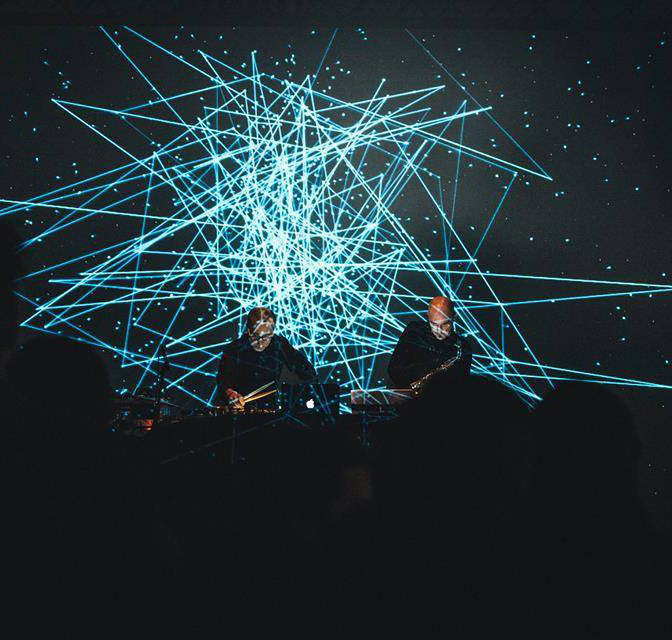OZMOTIC are an innovative duo with extensive musical affiliations. Located in Italy, the pair are comprised of Simone Bosco and Riccardo Giovinetto. Known for their experiments in electronica and glitch, the instrumental duo draw influences from artists such as Miles Davis, Steve Lacy, Pan Sonic amongst others, OZMOTIC’s style could be compared to artists like Alva Noto, Boards of Canada and even hints of Jon Hopkins, or rather a cohesive blend of all three.
OZMOTIC have also collaborated with Fennesz, Senking and Frank Bretschneider and have hypnotized fans with their artistry of cinematic layering and electro infused ambient sounds. Their use of an array of electronic equipment paired with mixing different genres like IDM, noise and jazz create a unique sound that expresses OZMOTIC’s true form. OZMOTIC have announced their upcoming album “Elusive Balance” which is set to drop on the 6th July via TOUCH.
We caught up with OZMOTIC on sound language, vast experimentation and their upcoming album Elusive Balance:
To anyone unfamiliar with OZMOTIC’s voltaic scatter, how would you personally describe the music you produce?
OZMOTIC’s music was born from the encounter between our musical pasts, experiences and the use of digital technology. It’s not easy to label our music, and it’s even harder to do it on our own! We could say that there are traces of ambient, glitch, contemporary music, jazz, soundscapes etc in our music …. everything is held together by constant research and close attention to “sound”, to detail and form. Sound experimentation has always played a fundamental role for us and it will never end, but will always be explored further to achieve the results we want to achieve. Today, music is too often experienced as a consumer good and pure entertainment, we try to put the beauty of the sound and the attention to detail back into the center of the music. We think of our records and concerts as “works of art” that require an emotionally active approach, both on our part and on the part of the listeners. An extremely important role is linked to the concept we choose to generate the flow of ideas. Our upcoming album, Elusive Balance explores the relationship between humans and nature, as well as the search for balance between these two great entities.
The theme of equilibrium and its precariousness, and its natural tendency to achieve relative stability connects all living things. Equilibrium is also a junction point and evolutionary engine – unstable and elusive, ready to deteriorate and start a new reactions and mechanisms bringing organisms to a new harmony.
OZmotic’s latest album Elusive Balance was released earlier this year via Touch. Could you detail this recording process? And could you explain how it may have differed to recording 2016’s Liquid Times?
We worked closely together to define the conceptual framework of the recording project and the live performances to follow – we chose a set of ideas and isolate key words. Starting from these elements, we begin to prepare sound sketches, keeping very high attention to the space of the sound spectrum that each element must occupy: melody, rhythmic components, textures, low frequencies. soundscapes. After this phase the arrangement work begins. At the same time visuals are created, and the modality of reaction between images and sounds are developed. Finally we evaluate the forms of the pieces in relation to the overall work, the time (both duration and pulsation), the timbres, and weight of the instruments etc, and we think about the overall direction that the project is going in, in terms of sound and vision. Compared to Liquid Times, we used other compositional techniques, both for sounds and for structures. In Elusive Balance, we’ve tried to investigate the essence of their sounds to expand its emotional and compositional potential. Each track contains a search for a synthesis between sound elements apparently distant from each other, but in reality create a new balance – as poetic as it is musical.
The new album draws a sonic flow in which the melodic aspects are countered by glitches and angular sounds, and the ambient passages are subjected to heavy rains of rhythm, leaving space for dreamlike moments.
How did OZMOTIC get involved with acclaimed producer Christian Fennesz? And what did you take away from this experience?
In 2013, we proposed a collaboration with Christian. We played together for three days in a loft in Torino. The ‘spark’ was immediately born. On the artistic level, that made us consider recording an album with him. After some live shows, a very nice and constructive relationship was born.
In the summer of 2014, we met again for another live performance, and for a session in studio. From there, our first album Air Effect was born. We continued playing live with Christian and in 2015 he collaborated with us again for the creation of two tracks for our second album Liquid Times. On the one hand, it was important to release both albums with an artist who gave international credibility to our work, and on the other it was an experience that made us aware of the artistic path undertaken within a furrow in which we felt at ease.
Christian was a key figure for us, both from a strictly professional point of view and from an artistic point of view. And, not to be taken for granted, also from a human point of view!
What are your direct thoughts on the current state of the electronic music scene? Are there any ways in which you feel it could improve, or change for the better?
Within the musical areas of our interest, the new millennium has brought to light a sort of boundary line that can not be easily reached. The world of electronic music following the arrival of the digital, and after fierce experimentation lost, the use and abuse of the laptop, and a relationship with the performative side of music that is vital, crucial; We must ask ourselves how the audience can interact with the sound world that is enveloping them, and then we believe that the answer is unequivocal: the union of the digital world with the instrumental and performative world it can only lead to an explosive result, full of possibilities. And it is precisely here that there is much to do; find balances, forms, alternation, new timbres, complex rhythmic solutions, and more. Musical evolution, in the same way as other disciplines of human knowledge will be inevitable. For years to come, we believe that it will no longer make sense to talk about electronic or acoustic music. Also from a compositional point of view it would be opportune to reflect: The question is whether techniques like generative music can be considered compositions… on the other hand ‘Cage’ has extensively investigated the random music with the use of completely random techniques such as the puzzle on tap, or the ‘I Ching’, and also ‘Boulez’, used strictly serial compositional techniques. Both of these compositional approaches are based on elements that can now be entrusted to computers and produced in real time. Obviously the problem is that, with the software available today, it is extremely easy to compose and produce music and therefore, from our point of view, the discriminant is always the control and awareness of the elements that determine the final sound result.
Incorporating elements into different styles can be a tricky procedure – how do you feel the merging of diverse genres can improve, or devalue music in some way? And how have you personally evolved your own unique and visionary style?
As in all human activities, evolution is a natural process that often passes through hybridization between different disciplines; and also in the long history of music, crossings and grafts between different styles are part of a consolidated practice. This is not good or bad; it is simply an inevitable process.
As far as OZMOTIC is concerned, our artistic path has led us to explore and incorporate different musical areas into our language. We have also expanded our research to other artistic languages and fields. For us, an equal role with respect to music is that of visuals, which we have continuously developed trying to create in our live a unitary and overall flow between sound and images. We work regularly with performance art, installations and contemporary theatre. For us, this kind of approach is vital, allowing us to have many expressive and communicative possibilities.
OZMOTIC have already released some great collaborations in the past. But if OZmotic could collaborate with any artist on the planet – who would it be, and why?
Bjork, Alva Noto, Sakamoto.
How important do you feel the visual aspect of OZMOTIC’s uniquely curated aesthetic is in conjunction with the sound of your music?
Over the years we have focused on the identity of the project, an identity made up of many elements, details and nuances. Elaborating an artistic manifesto is not secondary to build a project like ours, and then besides having worked on “sound”, on the compositional forms, and on the relationship between our musical instruments and the digital components to have identified the references for us, fundamentally (the European cultured music, ambient, glitch music, electronic experimentation, the Idm, contemporary jazz), so we investigated the field of graphic design and audio-visual interaction. The link between sound, matter and vision is inherent in the nature of digital language; both are made up of the same minimal units. In many cases the sound is it’s graphic track, and the graphic track is the sound. This is a structural uniformity that takes place both at the level of data organization and processing and at the level of software. Given this the nerve point is that we have to find a balance between these parties. This is a goal that over time we have tried to always keep in mind and which we have already mentioned earlier, for the mainly musical question, but which at macro levels is even more present in the relationship between audio and video. The two flows, the audio and the video, must be born in parallel, follow the same conceptual lines and condition each other, so as to become unique, and in relation to this the work, it must be developed whilst searching for this balance both through flows of hierarchies (what is more important and what is less for each phase of the project), dynamics (kinematics and luminosity), interaction in real time (clearly, but not in a banal way, of “movements” of sound and physical actions to visual events) and last but not least, have an overall evolving narrative, both in terms of sound and vision.
What does the future hold for OZMOTIC?
In the next few months, and after the release of the new album we will focus on live performances. We will continue to develop our work in different fields, maintaining the centrality of music. Elusive Balance will not only be a record, it will have other variations.
We will further develop the potential of real-time interaction between visuals and sound.
Preorder for Elusive Balance by OZMOTIC coming soon!
For more information follow OZMOTIC on Facebook




